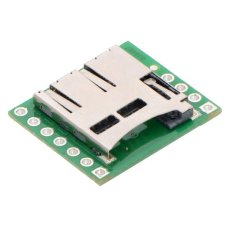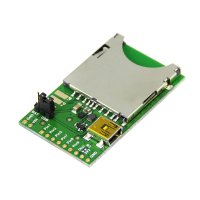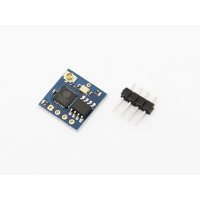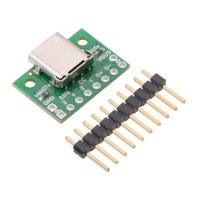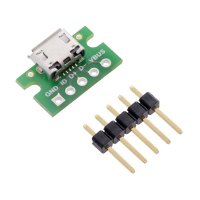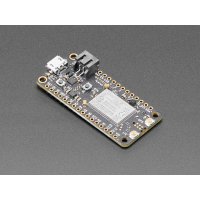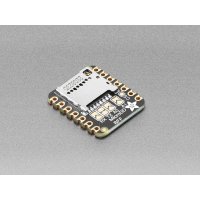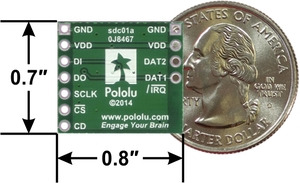
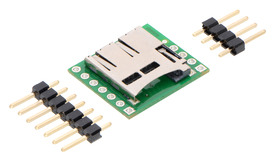
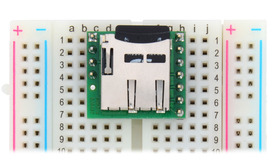
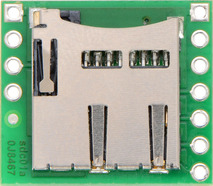

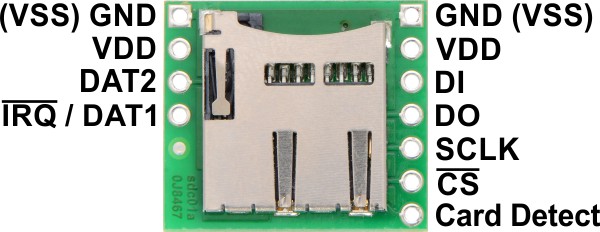
| Pin | Description | ||
|---|---|---|---|
|
GND (VSS) |
Power and logic ground | ||
| VDD | Supply voltage (2.7 V to 3.6 V for standard microSD cards) | ||
| CD | Card detect. When a card is inserted, this pin is floating; when no card is inserted, it is shorted to ground. A pull-up resistor can be used to pull the line high when a card is present. | ||
| SPI mode | SD mode | ||
| Pin | Description | Pin | Description |
| DI | Data in (MOSI) | CMD | Command/response |
| DO | Data out (MISO) | DAT0 | Data (bit 0) |
| SCLK | Clock | CLK | Clock |
| CS | Chip select (active low) | DAT3 | Data (bit 3) |
|
— IRQ |
Reserved Interrupt (active low; SDIO devices only) |
DAT1 IRQ |
Data (bit 1) Interrupt (active low; SDIO devices only) |
| — | Reserved | DAT2 | Data (bit 2) |
- The SD library for Arduino provides functions for accessing files and directories on an SD card. (It also works with Arduino-compatible boards like our A-Star programmable controllers.)
- The SD Card File System library for mbed allows similar filesystem access.
Schematic:
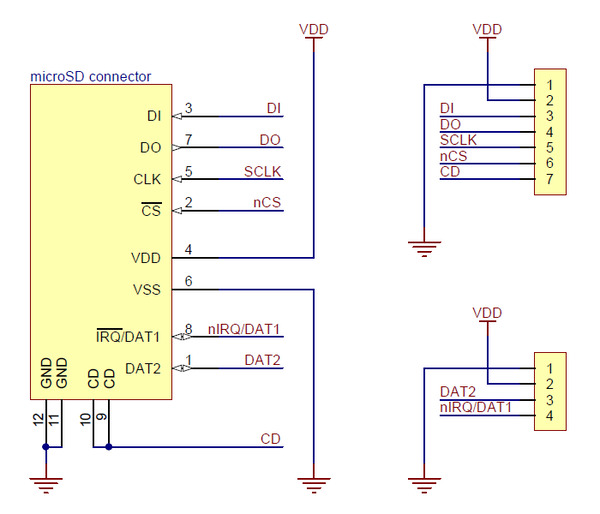
| Physical Attributes | |
| Weight | 1.3 g |
| Dimensions | 0.8″ × 0.7″ × 0.12″ |
Pololu 2597 Breakout Board for microSD Card
- Brand: Pololu
- Product Code: Pololu-Breakout-Board-microSD-Card
- Reward Points: 4
- Availability: In Stock
- रo 391.00
-
रo 376.00
- Price in reward points: 391
-
- 25 or more रo 377.00
- 96 or more रo 357.00
- 250 or more रo 344.00
Related Products
Electric Imp April - Breakout Development Board
Electric Imp April is a very simple breakout board with the minimum required components for an imp00..
रo 1,549.00
WiFi Serial Transceiver Module Breakout Board - ESP8266 ESP-05
This is a breakout board of WiFi serial transceiver module, based on ESP8266 SoC also known as ESP-0..
रo 355.00
Pololu 2585 USB 2.0 Type-C Connector Breakout Board
This simple board breaks out the power, USB 2.0 data, configuration, and sideband pins of a USB Type..
रo 376.00 रo 391.00
Pololu 2586 USB Micro-B Connector Breakout Board
This simple board breaks out all five pins of a USB Micro-B connector to a 0.1″ pin spacing that is ..
रo 189.00 रo 196.00
Adafruit 4753 Icarus IoT Board V2 nRF9160
The Icarus is a cost-effective cellular IoT board built around Nordic Semi's nRF9160 modem and combi..
रo 17,539.00
Adafruit 5683 microSD Card BFF Add-On for QT Py and Xiao
Our QT Py boards are a great way to make very small microcontroller projects that pack a ton of powe..
रo 297.00

